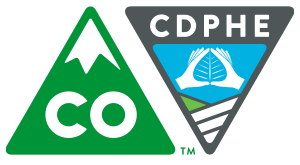Chronic Wasting Disease (CWD) and Public Health Issues
Disease in humans resulting from CWD exposure has not been reported to date. However, there may be a small risk from eating meat from infected animals. Consequently, public health officials recommend that people avoid exposure to CWD-infected animals.
Please see the Colorado Department of Public Health and Environment website for the most current recommendations on carcass testing and other preventive measures.
Minimize Exposure to CWD and Other Diseases of Potential Concern
CPW and state public health officials advise:
Hunters not to shoot, handle or consume any deer, elk or moose that is acting abnormally or appears to be sick.
When field-dressing game, wear rubber gloves and minimize the use of a bone saw to cut through the brain or spinal cord (backbone).
Minimize contact with brain or spinal cord tissues, eyes, spleen, or lymph nodes. Always wash hands and utensils thoroughly after dressing and processing game meat.
What Portions of Deer, Elk and Moose Should be Consumed?
Strong evidence suggests that abnormal proteins, called prions (pree-ons), cause chronic wasting disease in deer and elk. Research indicates that the prions naturally accumulate in certain parts of infected animals -- the brain, eyes, spinal cord, lymph nodes, tonsils, pancreas and spleen - relatively early in the course of disease, well before the animal is visibly ill. However, abnormal prions also can accumulate in a wider variety of tissues and organs, including kidney, lung, heart, and muscle.
Use these simple precautions to avoid CWD contamination:
Do not shoot, handle or consume any animal that appears sick; contact a Colorado Parks and Wildlife office if you see or harvest an animal that appears sick.
Wear rubber gloves when field dressing and processing animals.
Bone out the meat from your animal, and minimize handling of brain and spinal tissues.
Wash hands and instruments thoroughly after field dressing is completed.
Avoid consuming brain, spinal cord, eyes, spleen, tonsils, pancreas and lymph nodes of harvested animals. Normal field dressing, coupled with boning out a carcass, will remove most, if not all, of these body parts. Cutting away all fatty tissue will remove remaining lymph nodes.
Do not consume meat or organs from animals known to be infected with CWD.
Knives, saws and cutting table surfaces can be disinfected by soaking in a solution of 50 percent unscented household bleach and 50 percent water for an hour. Thoroughly rinse all utensils in water to remove the bleach. Afterward, allow them to air dry.
Help Prevent the Spread of CWD
One important step all Coloradans can take is to become informed on the importance of not feeding deer and other wildlife. Feeding big game is bad for wildlife and dangerous for people. This is an extremely important element for preventing the spread of CWD. Feeding wildlife not only creates dependency on humans, but can also help propagate the spread of CWD in these animals.
Carcass Disposal
Colorado Parks and Wildlife (CPW) currently advises that all parts of a CWD-infected animal, including processed meat, should be carefully contained in two heavy duty plastic garbage bags and put out with the weekly trash or brought to the local landfill, and further recommends that each plastic garbage bag be independently tied.
 Similar Prion Diseases
Similar Prion Diseases
Chronic wasting disease belongs to the family of prion diseases, also known as transmissible spongiform encephalopathies.
Within this family of diseases, there are three that affect cloven-hoofed animals: scrapie in domestic sheep and goats, which has been recognized for more than 200 years; bovine spongiform encephalopathy in cattle (sometimes referred to as "Mad Cow Disease"); and chronic wasting disease in deer, elk and moose.
There also are two main forms of prion disease that affect humans: Creutzfeldt-Jakob Disease, which occurs naturally in about one out of every one million people in Colorado and elsewhere around the world; and variant Creutzfeldt-Jakob Disease, which has been linked to human exposure to the large-scale outbreak of bovine spongiform encephalopathy in cattle herds in Great Britain and Europe (http://www.cjd.ed.ac.uk/).
For more information about prion diseases, please visit the Colorado Department of Public Health & Environments website.

